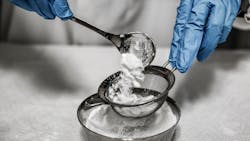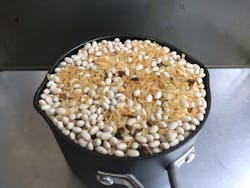Measuring the loose bulk density of powders and bulk solids
A bulk solid material’s loose bulk density (LBD) can be defined as the mass of an uncompacted sample of the material divided by the volume that the sample occupies. The most common units for measuring LBD are lb/ft3, kg/m3 or g/ml. Note that a milliliter is the same volume as a cubic centimeter, so 1 g/ml is the same as 1 g/cm3. The units of lb/ft3 and kg/m3 are used in bulk handing situations, while g/ml is more commonly used in laboratory settings.
A material’s true particle density (or intrinsic density) is designated in g/cm3. The difference between a material’s particle density and LBD can be large, so be careful which measurement you are referring to when using published references. For example, the LBD of TiO2 pigment may be 0.6 g/ml, while solid TiO2 has a particle density of 4.23 g/cm3. More typically, nylon pellets have an LBD of about 0.64 g/ml, while a solid particle (or solid block) of nylon has a density of 1.14 g/cm3. Many organic chemicals in bulk solid form will have LBDs less than 1.1 g/ml, while their corresponding particle densities will almost always be greater than 1.0 g/cm3.
The importance of loose bulk density
LBD is often the most critical single parameter describing a bulk solid material from a handling perspective. It closely relates to the storage capacity of bins and silos and the throughput capability of mechanical conveyors, feeders and rotary valves. LBD is directly related to flowability since denser powders usually flow better.
Two notable instances where LBD is important are dosing systems, which use the volume of the bulk solid as a surrogate for its mass, and the fill volume of packages that are sold by weight. The volume/mass relationship is critical to the design of high-speed packaging machines and in tablet making. Package size issues may seem trivial, until you have to deal with them. For some types of products, the LBD can vary day-by-day, meaning that the size of package necessary to neatly contain a certain mass may also need to change. This can be disastrous for consumer products, where there is a requirement for uniformly sized, neat packages. For industrial manufacturers of bulk solids, having more than one package size for the same product may lead to customer concerns regarding quality control or product uniformity.
The relationship between particle density and LBD is complex and cannot be reduced to a formula or rule of thumb. Mathematical relationships can predict the particle packing structures obtained under ideal circumstances with simple shapes, with a typical theoretical LBD value being about 63% of the particle density. Such “ideal” circumstances include a container without walls, a complete lack of interparticle friction and perfectly shaped particles of prescribed sizes. However, containers without walls do not exist, and idealized values of friction and shape are not likely to occur, especially for powders and particles whose shape is not specifically created by a manufacturing process. In the case of TiO2 particles, the LBD is only about 14% of the particle density due to very high levels of interparticle friction and irregular particle shapes.
Interparticle forces and irregular particle shapes can cause particles to pack together in random ways, meaning that the density of a stationary pile of powder can vary a great deal. Some powders can be compressed by as much as 50% in routine handling, and the amount of external disturbance (such as stirring or fluffing) needed to relax that prior history can be significant.
For example, I measured the loose bulk density of a sample of powdered sugar using three different methods. First, I used a measuring container as a scoop to remove the top layer from a 2-pound bag and measured an LBD of 0.555 g/ml. Next, I used a spoon to transfer small amounts of powdered sugar from the bag to a measuring container and measured an LBD of 0.464 g/ml. Finally, I tapped the previously compacted powder through a screen so that it “rained” down into the measuring container and measured an LBD of 0.445 g/ml.
Measuring loose bulk density
LBD can only be vaguely defined, because we can never really quantify whether the particles are truly “loose” in the measurement process. The looser the particles, the lower the LBD is likely to be. For this reason, I consider the most accurate measurement of LBD to be the one that produces the lowest value in a highly reproducible way. Any lab measurement that is not reproducible will not be trusted or will create a need for multiple replicate tests to narrow the confidence limits.
Correct measurement of LBD is not difficult. The technique and tools are simple and inexpensive, and extremely reproducible results can be obtained with careful attention to procedures and the characteristics of the material being measured. The only tools that are always needed are a suitable container, a straight edge or spatula, and a gram balance. A sieve or screen is recommended for some powders. A bowl and a spoon complete the kit.
Select a suitable measurement container
The walls of the measurement container can greatly affect the resulting LBD measurement for two reasons. First, if the walls are relatively close together compared to the material’s particle size, the packing structure across the width of the container will be inconsistent, leading to significant void spaces. As a rule, the container should be at least 10 — and preferably 30 or more — particle diameters wide. While this isn’t an issue for powders, it can be for materials with larger particles.
The second effect concerns the friction of the particles against the container walls. We know from silo design theory that friction against the walls will carry a portion of the weight of a bulk solid material and reduce the compaction of the material due to its own weight. This effect becomes increasingly pronounced if the container has a height-to-diameter ratio of more than about 1.0 and if the material has a high level of frictional interaction with the walls. LBD measurement is not intended to be a description of wall friction, but if you are not careful, this extraneous variable will affect your LBD measurement results.
The epitome of an inappropriate tall, thin container is the graduated cylinder frequently used for LBD measurement. These containers are a poor choice for LBD measurement if the particles are larger than 1/10 of the cylinder diameter or if the cylinder is filled more than one diameter full. A further problem with the use of graduated cylinders is reading the level in the cylinder. When the cylinder is loaded, the surface is almost never flat and perpendicular to the wall, leading to various methods such as tamping, tapping, or shaking to provide an unambiguous level measurement. These efforts will compact the material in an inconsistent way. Additional errors may occur due to interpolation when reading the measurement scale on the cylinder.
One legitimate reason to use a graduated cylinder for density measurement is as part of a series of measurements of the tapped bulk density. Tapped bulk density is a different parameter than LBD and, along with the compressed bulk density, provides further characterization of a bulk solid material’s properties. As with the relationship between LBD and particle density, we cannot predict either the tapped or compressed bulk density from the LBD.
The minimum container size is determined by the 10- or 30-diameter rule and a goal of having a height-to-diameter ratio of less than one. Larger containers are okay but require more sample material and sample handling. Very small containers may be difficult to weigh accurately. The container should not be rectangular unless it is large, since square corners will interfere with particle packing. Slightly rounded bottom corners are helpful for cleaning, and metal (versus glass or plastic) construction is best for static charge dissipation. The top surface of the container must have a flat edge, and any pouring spouts must be flush with the top edge.
Like graduated cylinders, laboratory beakers are a poor container choice due to their high height-to-depth ratio, recessed spout and plastic or glass construction. The recessed spout makes it impossible to level off the top surface of the container after it has been filled. The containers pictured in this article were purchased at a kitchen store, which may offer more viable options than lab supply sources.
Determine the container volume
Measure the precise volume of the container using water. Do not trust any printed information or measurements with a ruler. Find a gram balance (scale) of sufficient capacity to accurately weigh the container when it is full of water. Note the tare weight of the empty container. Have some towels ready to mop up spills and place the container on the scale. Carefully and very slowly fill the container with water until it is completely full to the brim. Note the weight in grams. This is equal to the container volume in ml. Fully dry the empty container before filling it with your material.
Fill and level the material properly
Figure 1 shows a small container, 6.9 cm in diameter, that is suitable for measuring the LBD of powders. I define powders as collections of particles that are entirely smaller than 500 microns (0.5 mm) and especially those smaller than about 100 microns. As particle sizes become smaller, interparticle forces increase and residual compaction is more likely to affect LBD measurements. Without corrective action, portions of the sample being measured will not be “loose.”
If the particles are homogeneous in chemical composition and entirely smaller than 100 microns, the best way to break up the compaction and fill the container is by hand tapping the powder through a ~2-millimeter (10-mesh) sieve above the container so that the powder disperses and “rains” gently into the container. (The 2-millimeter sieve size is a practical compromise between the desire to completely disperse the particles and the effort necessary to tap the powder through the sieve openings.) Continue hand sieving until the entire container is overflowing, with no low spots. Do not allow the sieve to touch the container, and do not shake, tilt or tap the container to level its contents.
Once the container is filled, use a straight edge or spatula to scrape the top surface flush with the edge of the container. The straight edge should be held at an upward 45-degree angle to the surface so that its action is to lift excess material off the surface, as shown in Figure 1. Never angle the straight edge downward, which will push down on and compact the material.
Segregation is the unintended separation of the components of a mixture of particles based on differences in size, shape, density or other properties. You do not want to measure the LBD (or any other bulk property) using a segregated sample. The odds of segregation in handling increase rapidly as particle size increases and the influence of the interparticle forces that impair segregation decreases. The sieve dispersing process that is ideal for fine powder LBD measurement is not recommended for larger particles that are prone to segregation, since the sieve is likely to promote the separation of particles based on size or another physical property.
Figure 2 shows a mixture of rice and beans in a suitable container. Both the rice and the beans are extremely free flowing, making segregation of the sample a major risk. To minimize segregation in such mixtures, place the starting sample in a round-bottomed bowl slightly larger than the measurement container and stir it vigorously, then use a small spoon to transfer the mixture into the measuring container. Thoroughly stir the bowl before taking each spoonful. The spoon should be sized and used so that at least 10 spoonfuls are required to fill the container.
One of my clients recently made a series of three measurements of a free-flowing, fluffy bulk solid with a broad particle size distribution using this method. On the first three tries, they measured 0.200 g/ml, 0.200 g/ml, and 0.199 g/ml, demonstrating the method’s remarkable consistency. The bowl and spoon technique can also be used for fine powders, but there will be greater variability in the LBD measurement results and the measured LBD will be slightly higher than with the sieve method.
If you know the intended starting proportions of a bulk solid mixture, you can add the individual ingredients to a bowl, mix them together, and then transfer with a spoon to a measuring container. It is not currently possible to use an equation or computer model to precisely calculate the LBD of a mixture of realistic particles based on their individual particle attributes. In fact, laboratory LBD measurements are frequently used to calibrate computer models of packing behavior.
Organic plant residue and recycle streams may consist of large pieces or particles with extreme aspect ratios that pose special challenges for LBD measurement. It may not be practical to have a container 10 times wider than the largest particle. Mechanical interlocking of particles will affect their LBD much more than surface friction or interparticle attraction.
Figure 3 shows a snack mix. The reproducibility of LBD measurements for such materials will be lower than for other bulk solids due to the lack of homogeneity in the sample and random interlocking events. Always use the largest possible container to minimize these effects. Sprinkle the fill into the container by hand. It may be necessary to judiciously hand pick especially difficult particles out of the sample container. When scraping the top surface level with a straight edge, particles that protrude above the surface may be broken off flush or plucked out of the container by hand. If the removal of a protruding particle leaves a void large enough to fill with a smaller particle, select a filler particle from the source sample and use it to fill the hole.
The snack mix shown in Figure 3 was originally packaged in a tall, round plastic bottle that was 14 cm in diameter — clearly less than 10 particle diameters. I transferred the entire package by hand from the bottle to a temporary bowl. When I finished taking pictures for Figure 3 and attempted to put the snack mix back into the plastic bottle, it would not fit. Particles extended about 3 cm beyond the top rim. A sharp rap on the bottle was sufficient to drop the fill level below the rim. Two more sharp raps dropped the fill level enough to give the impression that I had been short-changed when I bought the package. This illustrates the critical effects of container size, shape, and filling method on the measured values of loose bulk density.
Tim Bell is an independent consultant for the design and troubleshooting of bulk solids handling systems and the handling attributes of powdered and granular products. He was previously senior engineering fellow at DuPont, where he worked for 44 years specializing in the measurement of bulk solids properties and the design of powder handling and processing systems.
About the Author

Timothy A. Bell
Independent consultant
Tim Bell is an independent consultant for the design and troubleshooting of bulk solids handling and processing systems. He previously led DuPont’s competency in solids handling and chaired ASTM committee D-18.24, guiding the measurement of bulk solid properties for handling purposes. He can be reached at [email protected].



